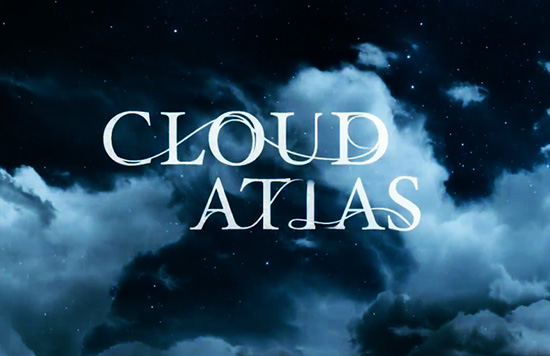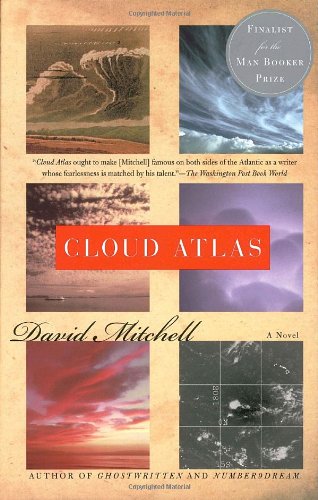Structure of Clouds – Cloud Atlas Book Review

About 7:40pm this past Saturday, I finished reading David Mitchell’s Cloud Atlas. At 10pm that same night, Mike and I caught the Wachowski/Tykwer film version. I was excited, to say the least.
I cannot claim to be a die-hard fan of this work, as I did not know anything about the book until Mike showed me the film trailer about a month ago. But having decided to see the film, I knew I wanted to read the book before the theatre experience. Now that I have read Cloud Atlas, I’m happy to say I will be reading other Mitchell books. Why? Because I was blown away – by theme, language, and primarily structure.
I freely admit to being a symmetry whore, whether that symmetry is physical, audible, literary, or artistic. And I am especially partial to symmetry if it is all of the above. As such, I pay careful attention to structure, whether it is in writing, a painting, or a building. Cloud Atlas is by far one of the most remarkable feats of literary structure that I have ever experienced. The book consists of six stores spanning six lifetimes and hundreds (or maybe thousands) of years. These stories are nested within each other – much like the Russian matryoshka dolls. Each story, with the exception of the final story, breaks off in the middle, and the reader moves to the next. Then, after reading the final story all the way through, the reader begins to work backward again until all stories are told. Why is this brilliant? Well, let’s begin at the beginning.
!Possible Spoilers Here!

Adam Ewing is an American lawyer on business in the South Pacific in the 1850’s. He keeps a journal, and his story is told through that writing. Ewing’s story literally breaks off mid sentence, and the reader moves to Robert Frobisher, an English composer living in Belgium and working as an amanuensis for a world renown composer in the 1930’s. Frobisher’s story is told through letters to his friend/lover Rufus Sixsmith, and he happens to find and read a published version of Ewing’s journal. Of course, he is missing half of the journal, which ends mid sentence. The reader then moves on to the adventures and work of Luisa Rey, a Californian journalist, hot on the trail of a huge nuclear conspiracy/cover-up in the 1970’s. She meets Sixsmith, who is now an old man, and targeted by an energy company because his report will force closure of their facility. Rey ends up with Frobisher’s letters and reads them. Moving forward, the reader meets senior, Timothy Cavendish, a vanity publisher from London living in the present time. Mr. Cavendish, because of complications and misunderstandings, ends up trapped in a nursing home. As he travels unwittingly to the nursing home, he reads a novel about Lusia Rey, which was submitted to him for publication. In the distant future, Sonmi-451, an awakened clone (called a Fabricant in the novel) watches a film about Mr. Cavendish’s ordeal in a new Seoul Korea that is ruled by corporate business called “Corprocracy”. Sonmi’s story is told through an interview conducted before she is to be executed. That interview is subsequently viewed in the far future by Zachary, a man whose tribe on Hawaii has survived a nuclear Holocaust called “The Fall”. And at the conclusion of Zachary’s story, the reader begins to work backwards, experiencing the conclusions of all stories, ending with Adam Ewing, where we began.
So as cool as this is, what makes it brilliant? The structure is supported by reoccurring images, themes, and conflicts, and each narrative carries over into its successor through some version of story. But the most remarkable characteristic is how the novel mirrors the musical composition of its title “The Cloud Atlas Sextet”, which Robert Frobisher composes. A sextet is a musical composition for six instruments or performers. In one of Frobisher’s letters, he describes his as “a sextet for overlapping soloists: piano, clarinet, ‘cello, flute, oboe, and violin, each in its own language of key, scale, and color. In the first set, each solo is interrupted by its successor: in the second, each interruption is recontinued in order.” This structure is replicated exactly in the novel if we equate the stories to the solos.
Cloud Atlas exposes human tendency to walk over others in order to gain more money, material possessions, and power. While our exploitation of others may change names (ie. Slavery as an institution is nonexistent in the 1970’s), humans are still using, manipulating, and crushing others to gain just a little more. This conflict carries throughout all the stories. Of course, there are differences, just as there would be between a violin and a flute playing the same melody. And that is Mitchell’s point.
I could spend even more time discussing his outstanding use of language to denote time periods (even a couple that haven’t happened yet) and show how language changes and is influenced. I could spend many pages discussing the themes of greed, slavery, and abuse and simplicity, justice, and compassion. Mitchell’s words are poignant and, at times, tough medicine but need to be spoken.
And though this review has run long enough, please read Cloud Atlas. It is bold and breathtaking.
Leave a Reply